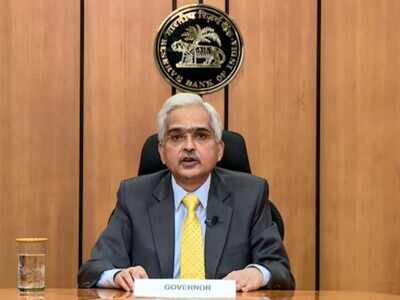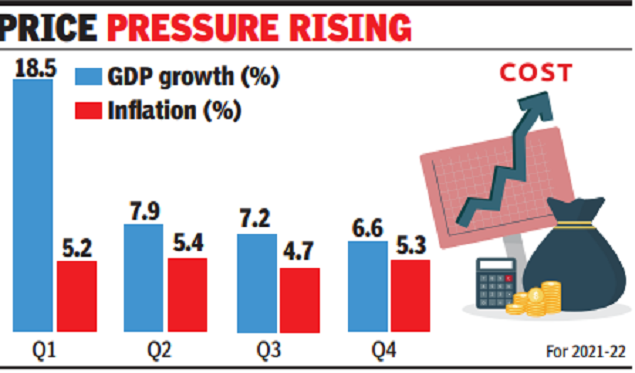Top Searches
- News
- Business News
- India Business News
- Reserve Bank of India cuts growth estimate to 9.5%
Reserve Bank of India cuts growth estimate to 9.5%

NEW DELHI: The Reserve Bank of India (RBI) on Friday left key policy rates unchanged but slashed its growth estimate for 2021-22 to 9.5% from a projection of 10.5%, citing the impact of the second wave of the pandemic. The central bank, however, raised the inflation estimate a tad higher to 5.1% due to gathering price pressures.
RBI governor Shaktikanta Das said the second wave of Covid is associated with unexpectedly higher rates of morbidity and mortality relative to the first wave. The break out of mutant strains that render the coronavirus highly transmissible across both urban and rural areas has led to fresh restrictions on activity being imposed across a large swath of the country, he said.
“Yet unlike in the first wave, when the economy came to an abrupt standstill under a nationwide lockdown, the impact on economic activity is expected to be relatively contained in the second wave, with restrictions on mobility being regionalised and nuanced. Moreover, people and businesses are adapting to pandemic working conditions,” the governor said.

Das said that notwithstanding the sequential decline of indicators in April, rural demand is expected to remain strong as forecast of a normal monsoon bodes well for sustaining its buoyancy going forward. The increased spread of Covid infections in rural areas, however, poses downside risks. Taking all these factors into consideration, real GDP growth is now projected at 9.5% in 2021-22, consisting with the economy projected to expand 18.5% in the June quarter.
On Monday, chief economic adviser Krishnamurthy Subramanian had said that the impact of the second wave will not be very large, although he refrained from releasing a fresh estimate.
The RBI is the latest to join a long list of economists, multilateral agencies, investment banks and brokerages, which have cut the country’s growth estimates against the backdrop of the second wave and its impact on the economy.
Das, however, said that the forecast of a normal monsoon, the resilience of agriculture and the farm economy, the adoption of Covid-compatible operational models by businesses, and the gathering momentum of global recovery were forces that could provide tailwinds to revival of domestic economic activity when the second wave abates.
On the other hand, the spread of the coronavirus infections in rural areas and the dent on urban demand pose downside risks. Ramping up the vaccination drive and bridging the gaps in healthcare infrastructure and vital medical supplies can mitigate the pandemic’s devastation, the governor added.
RBI governor Shaktikanta Das said the second wave of Covid is associated with unexpectedly higher rates of morbidity and mortality relative to the first wave. The break out of mutant strains that render the coronavirus highly transmissible across both urban and rural areas has led to fresh restrictions on activity being imposed across a large swath of the country, he said.
“Yet unlike in the first wave, when the economy came to an abrupt standstill under a nationwide lockdown, the impact on economic activity is expected to be relatively contained in the second wave, with restrictions on mobility being regionalised and nuanced. Moreover, people and businesses are adapting to pandemic working conditions,” the governor said.

Das said that notwithstanding the sequential decline of indicators in April, rural demand is expected to remain strong as forecast of a normal monsoon bodes well for sustaining its buoyancy going forward. The increased spread of Covid infections in rural areas, however, poses downside risks. Taking all these factors into consideration, real GDP growth is now projected at 9.5% in 2021-22, consisting with the economy projected to expand 18.5% in the June quarter.
On Monday, chief economic adviser Krishnamurthy Subramanian had said that the impact of the second wave will not be very large, although he refrained from releasing a fresh estimate.
The RBI is the latest to join a long list of economists, multilateral agencies, investment banks and brokerages, which have cut the country’s growth estimates against the backdrop of the second wave and its impact on the economy.
Das, however, said that the forecast of a normal monsoon, the resilience of agriculture and the farm economy, the adoption of Covid-compatible operational models by businesses, and the gathering momentum of global recovery were forces that could provide tailwinds to revival of domestic economic activity when the second wave abates.
On the other hand, the spread of the coronavirus infections in rural areas and the dent on urban demand pose downside risks. Ramping up the vaccination drive and bridging the gaps in healthcare infrastructure and vital medical supplies can mitigate the pandemic’s devastation, the governor added.
FacebookTwitterLinkedinEMail
Start a Conversation
end of article
Quick Links
ELSS Mutual Funds BenefitsIncome Tax Refund statusITR Filing Last DateHome Loan EMI TipsHome Loan Repayment TipsPradhan Mantri Awas YojanaTop UP Loan FeaturesIncrease Home Loan EligibilityHome Loan on PFTax Saving Fixed DepositLink Aadhaar with ITRAtal Pension YojanaAadhaar CardSBIReliance CommunicationsMukesh AmbaniIndian Bank Ifsc codeIDBI Ifsc codeIndusind ifsc codeYes Bank Ifsc CodeVijay Bank Ifsc codeSyndicate bank Ifsc CodePNB Ifsc codeOBC Ifsc codeKarur vysya bank ifscIOB Ifsc codeICICI Ifsc codeHDFC Bank ifsc codeCanara Bank Ifsc codeBank of baroda ifscBank of America IFSC CodeBOM IFSC CodeAndhra Bank IFSC CodeAxis Bank Ifsc CodeSBI IFSC CodeGST
